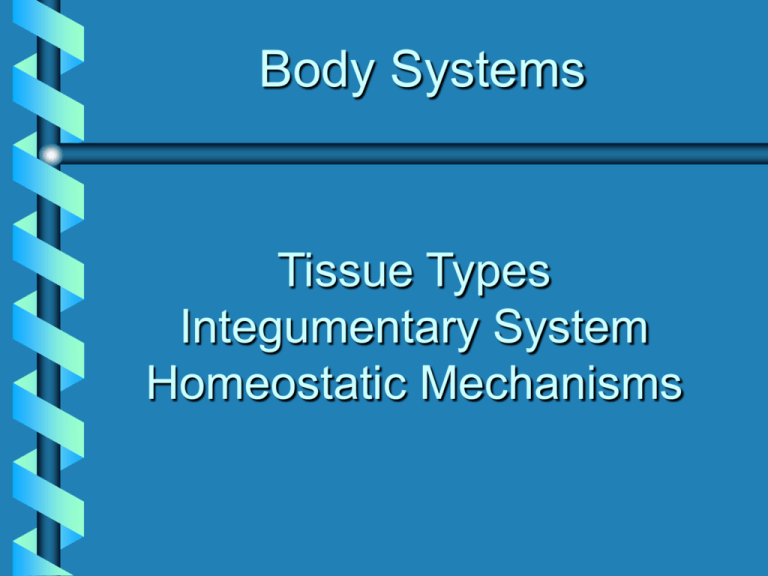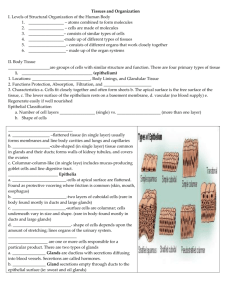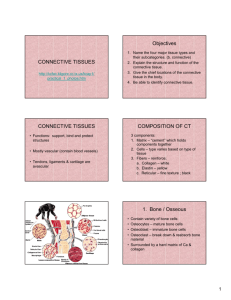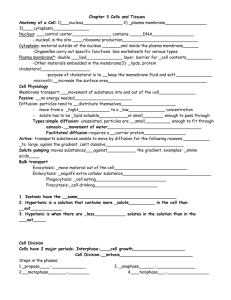flattened cells Columnar
advertisement

Body Systems Tissue Types Integumentary System Homeostatic Mechanisms Four Major Tissue Types • Connective: binds and supports body parts • Muscular: allows movement • Nervous: receives stimuli and conducts impulses • Epithelial: covers body surfaces, lines body cavities Three Components of Connective Tissue Specialized cells Ground Substance: Non-cellular material separating cells Protein Fibers Loose Fibrous Connective Tissue • Contains fibroblast cells • Matrix: ground substance + fibers • Protective covering for muscles, blood vessels, nerves Dense Fibrous Connective Tissue • Collagen fibers packed together • Forms – Tendons: connect muscles to bone – Ligaments: connect bone to bone Fibrous Connective Tissue: Adipose Tissue nucleus •Cells store fat •Found under skin, around kidneys, heart Supportive Connective Tissue: Cartilage • Solid, flexible matrix • Cells located in chambers – lacunae Elastic cartilage --elastin fibers --more flexible --outer ear Fibrocartilage --strong collagen fibers --between vertebrae and in knee joint Hyaline cartilage --most common --contains fine collagen fibers --nose, ends of long bones and ribs, walls of respiratory passages Supportive Connective Tissue: Bone • Solid, rigid matrix of calcium salts around collagen fibers • In compact bone, cells are located in spaces between rings of matrix Compact bone Spongy bone Fluid Connective Tissue: Blood • Liquid matrix = plasma – dissolved substances, eg. gases, ions – suspended substances, eg. proteins • Formed elements: cells and cell fragments – Red blood cells – White blood cells – Platelets • Cell fragments that aid in blood clotting Fluid Connective Tissue: Lymph • Liquid matrix = lymphatic fluid • Contains white blood cells Applying Your Knowledge 1. 2. 3. 4. Adipose Tissue Blood Bone Dense Fibrous Connective Tissue A. Which type of tissue has a liquid matrix? B. Which type of tissue stores fat? C. Which type of tissue has a solid matrix of calcium salts? Muscular Tissue • Cells are called muscle fibers • Cells contain protein filaments called actin and myosin cell striation nucleus Smooth Muscle Involuntary nucleus nucleus Skeletal Muscle Voluntary Cardiac Muscle Involuntary Nervous Tissue • Neurons- conduct nerve impulses • Neuroglia- support and nourish neurons Receives signals from other neurons Maintains cell metabolism Conducts signals to next neuron Insulates neuron Classification of Epithelial Tissue Squamous: flattened cells Pseudostratified Columnar Simple = one layer Pseudostratified = appears as multiple layers Stratified = multiple layers Cuboidal: cube-shaped cells Columnar: elongated cells Other Terms Related to Epithelial Tissue • Basement Membrane- joins epithelium to underlying connective tissue • Gland- epithelial tissue that secretes a product – mucus – hormones Applying Your Knowledge 1. 2. 3. 4. Nervous Tissue Epithelial Tissue Muscular Tissue Connective Tissue A. Which type of tissue includes cells in a solid matrix, as for cartilage? B. Which type of tissue covers body surfaces? C. Which type of tissue receives and transmits signals? D. Which tissue has cells with actin and myosin filaments? Integumentary System: Skin and Accessory Organs • Regions of the Skin – Epidermis • stratified squamous epithelium • cells become hardened due to keratin • continually replaced from basal layer • melanocytes give pigmentation Integumentary System: Skin and Accessory Organs • Regions of the Skin – Dermis • dense fibrous connective tissue • contains collagen and elastic fibers • contains sensory receptors for touch, pressure, pain and temperature • has blood vessels to nourish skin Integumentary System: Skin and Accessory Organs • Accessory Organs – Nails – Hair follicles – Oil glands – Sweat glands Integumentary System: Skin and Accessory Organs • Functions – Protects organs from physical trauma – Protects body from infections – Limits water loss – Regulates temperature Body Cavities Cranial cavity Vertebral canal Thoracic cavity Abdominal cavity Pelvic cavity Homeostatic Mechanisms Negative Ability to bring about a change Feedback in the opposite direction, leads to stability eg. temperature regulation Positive Rapid change in one direction Feedback eg. giving birth Control center sends data to control center directs response to stimulus 98.6F set point Sensor Effect Temperature Regulation Blood vessels dilate; sweat glands secrete. negative feedback and return to normal temperature stimulus Normal body temperature negative feedback and return to normal stimulus Effect Sensor Blood vessels constrict; sweat glands are inactive; shivering may occur. directs response to stimulus Control center sends data to control center 98.6F set point Body Systems Contributing to Temperature Regulation Integumentary System Circulatory System Nervous System Sweat glands Dilation or Constriction of Blood vessels Hypothalamus (regulatory center) Applying Your Knowledge 1. 2. 3. 4. Dermis Epidermis Positive Feedback Negative Feedback A. Which is the outermost skin layer? (1 or 2) B. Which skin layer contains blood vessels? (1 or 2) C. Which mechanism controls blood glucose levels? (3 or 4) D. Which mechanism causes a fever to increase to higher temperatures? (3 or 4)






